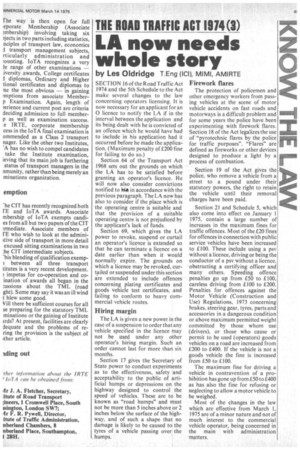THE ROAD TRAFFIC ACT 1914(3)
Page 47

If you've noticed an error in this article please click here to report it so we can fix it.
LA now needs whole story
by Les Oldridge T.Eng (ICI), MIMI, AM1RTE SECTION 16 of the Road Traffic Act 1974 and the 5th Schedule to the Act make several changes to the law concerning operators licensing. It is now necessary for an applicant for an 0 licence to notify the LA if in the interval between the application and its being dealt with he is convicted of an offence which he would have had to include in his application had it occurred before he made the application. (Maximum penalty of £200 fine for failing to do so.) Section 64 of the Transport Act 1968 sets out the grounds on which the LA has to be satisfied before granting an operator's licence. He will now also consider convictions notified to kit in accordance with the previous paragraph. The LA now has also to consider if the place which is the operating centre is suitable and that the provision of a suitable operating centre is not prejudiced by the applicant's lack of funds.
Section 69, which gives the LA power to revoke, suspend or curtail an operator's licence is extended so that he can terminate a licence on a date earlier than when it would normally expire. The grounds on which a licence may be revoked, curtailed or suspended under this section are extended to include offences concerning plating certificates and goods vehicle test certificates, and failing to conform to heavy commercial vehicle routes.
Hiring margin
The LA is given a new power in the case of a suspension to order that any vehicle specified in the licence may not be used under any other operator's hiring margin. Such an order cannot last for more than six months.
Section 17 gives the Secretary of State power to conduct experiments as to the effectiveness, safety and acceptability to the public of artificial humps or depressions on the highway designed to control the speed of vehicles. These are to be known as "road humps" and must not be more than 5 inches above or 2 inches below the surface of the highway, and of such a shape that no damage is likely to be caused to the tyres of a vehicle passing over the , humps.
Firework flares
The protection of policemen and other emergency workers from passing vehicles at the scene of motor vehicle accidents on fast roads and motorways is a difficult problem and for some years the police have been experimenting with firework flares. Section 18 of the Act legalizes the use of "pyrotechnic flares by the police for traffic purposes". "Flares" are defined as fireworks or other devices designed to produce a light by a process of combustion.
Section 19 of the Act gives the police, who remove a vehicle from a street to a pound under their statutory powers, the right to retain the vehicle until their removal charges have been paid.
Section 21 and Schedule 5, which also come into effect on January 1 1975, contain a large number of increases in the maximum fines for traffic offences. Most of the £20 fines for offences in connection with public service vehicles have been increased to £100. These include using a psv without a licence, driving or being the conductor of a psv without a licence, obstructing a certifying officer and many others. Speeding offence penalties go up from £50 to £100, careless driving from £100 to £200. Penalties for offences against the Motor Vehicle (Construction and Use) Regulations, 1973 concerning brakes, steering gear, tyres, parts and accessories in a dangerous condition or above maximum permitted weight committed by those whom use (drivers), or those who cause or permit to be used (operators) goods vehicles on a road are increased from £200 to £400. If the vehicle is not a goods vehicle the fine is increased from £50 to £100.
The maximum fine for driving a vehicle in contravention of a prohibition has gone up from £50 to £400 as has also the fine for refusing or neglecting to allow a motor vehicle to be weighed.
Most of the changes in the law which are effective from March 1, 1975 are of a minor nature and not of much interest to the commercial vehicle operator, being concerned in the main with administration matters.








































































































